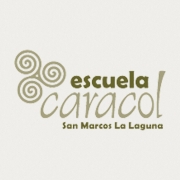Meet Neah Bay Douglas, our new Development Director

Escuela Caracol´s Development Director Neah Bay Douglas has been a supporter of the Waldorf movement for more than ten years beginning with the enrollment in parent-child classes (at Chicago Waldorf school) with her oldest son Jackson who is now 13. Recently her experience culminated in the founding and directing of a Waldorf-methods charter school in Colorado. She joined the Caracol community this past June and works most of the year from the United States but travels to San Marcos intermittently. Currently she is spending three weeks here with her two children, Jackson (13) and Artic (10). See more from their recent explorations in Guatemala on their travel blog: http://acordeoro.wordpress.com/
Neah, what job did you have before coming to Escuela Caracol?
I have worked in nonprofit leadership for many years with a focus on serving children at risk. Most recently I founded and directed a school in the United States (Colorado), a K-8 Waldorf-methods public charter school called Mountain Song Community School.
Why did you choose to work for Escuela Caracol?
Waldorf education is a powerful social movement that facilitates the development of communities fully in areas of the intellect, the heart and the body. It engenders from a full capacity the ability to authentically know and respect oneself and others. Rudolf Steiner, the founder of Waldorf education, said that “love is the greatest power of knowledge” and true education is formed through this power. The intention at Escuela Caracol comes from love and compassion. This is felt fully from the staff who have come from all over the world and are working together with local people who are both indigenous Maya and non-indigenous. Creative expression, practical work, the natural environment and social harmony are part of each day at Caracol. Also, there is an honest intention to celebrate and honor the traditional Maya culture while recognizing ways to integrate and emerge together as a new culture. It is a place of renewal, a place of beauty and a genuine representation of Waldorf education. There was also a lovely synchronicity in this opportunity for me because before I was born my father, who was a professor for a Native American college in the United States, spent a summer teaching an indigenous native american tribe, the Makah. This was in Neah Bay, Washington and that is where my name is from.
Can you share some of the highlights of your work on Escuela Caracol?
When I am able to work in San Marcos at the school there is a continuous expression of joy that is felt in abundance. The melody of the children’s laughter and singing drifts continuously through the buildings and gardens, and the beauty of each child is seen in their smiles, their art and handwork. A cherished moment that I will always remember is when Andrea, the grade 2-3 teacher was showing examples of her students’ main lesson books during a staff meeting. Her pride and love were fully expressed as she turned the pages of these beautiful hand-made books of language arts and mathematics. There was one particular student who had made extreme progress with his academics and emotional wellbeing. As everyone looked at his accomplishments it felt like the whole staff had one giant heart beating in perfect rhythm. The success of this student can largely be attributed to Andrea’s care and intention and to that of the entire staff. My experiences with all of the staff confirm their deep love and commitment to this wonderful school.
You have a lot of experience in Waldorf education. How do you think this pedagogy would benefit the community and Guatemala?
The pedagogy provides and maintains a pulse for regeneration and Escuela Caracol can be a model for Guatemala, a country still recovering from a 36 yearlong civil war. This comprehensive educational community can serve as a model of how to remove the residue of conflict, build intercultural solidarity and empower people to move out of a cycle of poverty. Three fundamental principles of Waldorf education provide strength for this community: freedom, equality and solidarity.
How do you imagine Escuela Caracol in the future?
I imagine Escuela Caracol flourishing and continuing to engage many students in multiple capacities preparing them for great opportunities in their lives. I see a thriving school that is fully enrolled and has equal representation of girl and boy students. I would also like to see the efforts of the school widening out through Guatemala through the offering of teacher training to many Guatemalan educators. And lastly I am hoping for ways to engage in social-impact initiatives that will put the needs and challenges of the community at its center and benefit not only the school but the whole Lake Atitlán region economically.

